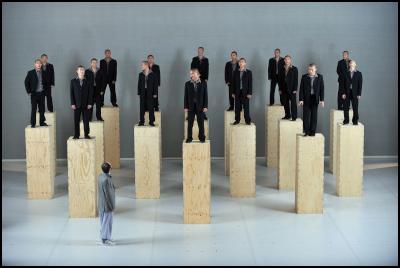Arts Festival Review: Sutra
Arts Festival Review: Sutra
Review by Lyndon Hood
Click to enlarge
Photo: Hugo Glendinning
Sutra
A Sadler's Wells
Production
Sidi Larbi Cherkaoui & Monks from the Shaolin
Temple
Set by Anthony Gormley
Music by Szymon
Brzoska
26 February – 6 March
St James
Theatre
It's possible some of the audience were thinking 'Shaolin Spectacular'. If that's what you're after, you won't lose out, but Sutra is more complicated than that. Its attempt to integrate those martial arts forms, and some of that spectacle, into modern dance results in a mix that is both impressive and intriguingly varied.
The large cast of warrior- (or rather performer-) monks from the famous Shaolin Temple do move spectacularly. The action if full of dives and somesaults, of contortionistic bending, of power and of risk; different of styles of rapid, swirling movement evokeing the actions of different totemic animals. As martial arts these were hugely impressive (though not quite flawless). In Sutra these are staggered through time or performed simultaneously; arranged formally, chaotically or in reflection; solo or group, fast or slow – and combined with moments of controlled clumsiness and personality – to make dance.
This idea of martial arts as choreography was enhanced by Anthony Gormley's set; an array of oblong, open wooden boxes, big enough to fit a dancer's body and infinitely rearrangeable. And behind a gauze screen, the musicians played Szymon Brzoska's score, detailed and modernistic incidental music emphasising the promise of an artistic rather than light entertainment focus to the performance.
The opening night audience wasn't especially inclined to clap at physical feats of that would have earned applause in other shows (or no doubt on other nights of this one). This may have skewed my impression; taking this spectacle for granted – which admittedly sounds churlish – I wondered where the 'hook' in the show actually was.
Sidi Larbi Cherkaoui, choreographer of and dancer in Sutra, has had a long standing interest in Shaolin and spent time at the Shoalin Temple preparing the piece. It is structured around episodes of himself and his uneasy introduction to that community, as he learns their craft and (as I read it) of turbulent and interrupted history of the Shoalin Temple.
He is deliberately, often comically awkward; his disomfort in this strange world displayed with a sometime dazzling level of skill. He has part of the set for himself – his own, metallic box which in one sequence becomes a fluid, gravity-free mixture of monk's cell and social prison. But I didn't feel compelled to sympathise with him or his brooding presence as he intensely contemplating these people and their ways, and it sometime seemed like self-indulgent autobiography.
There was a sense of Orientalism: the pervading idea of a mysterious and exotic East where hidden secrets are understood. The term was coined to pinpoint a kind of naïve racism. It doesn't help in this regard that some of the most effective comic moments are based around tricks of identity, or hiding and reappearing, that work because one man with close-cropped hair in a certain costume looks very like another.
But if we can't be orientalist about the Shoalin Temple, perhaps we should stop dreaming now.
Besides, it is probably unfair to apply the term here – Cherkaoui's piece is a product of sincerity and long and honest research. The idea only occurs because Sutra's story, as I followed it, seemed trite. In much the same way, the fact that a young boy, with the adorable movements of some agile, furred animal, became Cherkaoui's gateway into the Shaolin world, was lovely at the same time as being shamnelessly hackeneyed.
For myself, some of the most arresting moments were not especially based in the martial arts. The opening established an analogy between a set of tiny toy boxes in the corner of the stage – Cherkaoui tries to explain the show to the boy with a model – and the actual set. As the show goes on they are rearranged together.
And when the full-size pieces are carried, the action become an intriguing choreography of walking wooden boxes. This reached it climax in a sequence when they formed enormous moving blossom with the child, meditating, raised at its centre, but fascinated me most in the simple swirling motion as objects animated.
In the final moments of Sutra Cherkaoui merges, seamlessly, in with the group, as a sequence of Shaolin training actions are performed and group arrangements more akin to modern ballet, as if to finally and undeniably make the statement that this is dance. Amid the swelling music and movement I dropped my reservations.
Sutra is a compelling mixture of European dance and Eastern martial arts performance. It carries the flavours and some of the bitterness of both, and leaves plenty to chew on.
Press Releases: A
Journey through Faith and Imagination - New Dance Programme Defies Borders
TV3
Video: Reach
enlightenment with the kung fu monks
Arts Festival
website: Sutra
Scoop
Full Coverage: Arts Festival
2010


 Richard S. Ehrlich: Deadly Border Feud Between Thailand & Cambodia
Richard S. Ehrlich: Deadly Border Feud Between Thailand & Cambodia Gordon Campbell: On Free Speech And Anti-Semitism
Gordon Campbell: On Free Speech And Anti-Semitism Ian Powell: The Disgrace Of The Hospice Care Funding Scandal
Ian Powell: The Disgrace Of The Hospice Care Funding Scandal Binoy Kampmark: Catching Israel Out - Gaza And The Madleen “Selfie” Protest
Binoy Kampmark: Catching Israel Out - Gaza And The Madleen “Selfie” Protest Ramzy Baroud: Gaza's 'Humanitarian' Façade - A Deceptive Ploy Unravels
Ramzy Baroud: Gaza's 'Humanitarian' Façade - A Deceptive Ploy Unravels Keith Rankin: Remembering New Zealand's Missing Tragedy
Keith Rankin: Remembering New Zealand's Missing Tragedy